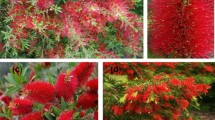Abstract
In this study, glutathione reductase (GR) from baker’s yeast (Saccharomyces cerevisiae) was exposed to 0, 25, 50, 100, 250 and 500 mg/L copper(II) oxide nanoparticles (CuO NPs) and copper(II) chloride (CuCl2). Changes in GR% activity upon exposure to 25, 50, 100, 250 and 500 mg/L CuO NPs and CuCl2 were found to be + 0.3, − 3.4, − 8.1, − 25.7 and − 37.4 and − 60.7, − 72.7, − 77.8, − 85.3 and − 90.6, respectively. The 50% inhibition concentration (IC50) was 625 ppm (78.6 × 10−4 M) for CuO NPs and 21 ppm (1.56 × 10−4 M) for CuCl2. Moreover, CuO NPs and CuCl2 inhibited GR competitively and noncompetitively, respectively.



Similar content being viewed by others
References
Abdel-Khalek AA, Kadry MAM, Badran SR, Marie MAS (2015) Comparative toxicity of copper oxide bulk and nano particles in nile tilapia; Oreochromis niloticus: biochemical and oxidative stress. J Basic Appl Zool 72:43–57
Burke J, Handy RD (2005) Sodium-sensitive and -insensitive copper accumulation by isolated intestinal cells of rainbow trout Oncorhynchus mykiss. J Exp Biol 208(2):391–407
Canlı EG, Canlı M (2017) Effects of aluminum, copper, and titanium nanoparticles on some blood parameters in Wistar rats. Turk J Zool 41:259–266
Canli EG, Atli G, Canli M (2017) Response of the antioxidant enzymes of the erythrocyte and alterations in the serum biomarkers in rats following oral administration of nanoparticles. Environ Toxicol Pharmacol 50:145–150
Carlberg I, Mannervik B (1975) Purification and characterization of the flavoenzyme glutathione reductase from rat liver. J Biol Chem 250(14):5475–5480
Elia AC, Magara G, Righetti M, Dörr AJM, Scanzio T, Pacini N, Abete MC, Prearo M (2017) Oxidative stress and related biomarkers in cupric and cuprous chloride-treated rainbow trout. Environ Sci Pollut Res 24:10205–10219
Fersht A (ed) (1985) Enzyme structure and mechanism. W.H. Freeman and Company, New York
Greulich C, Diendorf J, Simon T, Eggeler G, Epple M, Köller M (2011) Uptake and intracellular distribution of silver nanoparticles in human mesenchymal stem cells. Acta Biomater 7(1):347–354
Halliwell B, Gutteridge JMC (1999) Free radicals in biology and medicine, 3rd edn. Oxford University Press, New York
Hoseini SM, Hedayati A, Mirghaed AT, Ghelichpour M (2016) Toxic effects of copper sulfate and copper nanoparticles on minerals, enzymes, thyroid hormones and protein fractions of plasma and histopathology in common carp Cyprinus carpio. Exp Toxicol Pathol 68:493–503
Hu HL, Ni XS, Duff-Canning S, Wang XP (2016) Oxidative damage of copper chloride overload to the cultured rat astrocytes. Am J Transl Res 8(2):1273–1280
Husain N, Mahmood R (2019) Copper(II) generates ROS and RNS, impairs antioxidant system and damages membrane and DNA in human blood cells. Environ Sci Pollut Res 26:20654–20668
Janrao KK, Gadhave MV, Banerjee SK, Gaikwad DD (2014) Nanoparticle induced nanotoxicity: an overview. Asian J Biomed Pharma Sci 4:1–7
Karadağ H, Eroğlu E, Kırılmış C (2019) Determination of glutathione reductase activity changes exposed to some 2-aminothiazole derivatives. Cumhuriyet Sci J 40(1):136–140
Keller AA, Wang H, Zhou D, Lenihan HS, Cherr G, Cardinale BJ, Ji Z (2010) Stability and aggregation of metal oxide nanoparticles in natural aqueous matrices. Environ Sci Technol 44:1962–1967
Klaine SJ, Alvarez PJ, Batley GE, Fernandes TF, Handy RD, Lyon DY, Lead JR (2008) Nanomaterials in the environment: behavior, fate, bioavailability, and effects. Environ Toxicol Chem 27:1825–1851
Lowry OH, Rosebrough NJ, Farr AL, Randall RJ (1951) Protein measurement with the folin phenol reagent. J Biol Chem 193:265–275
Nelson DL, Cox MM (2004) Lehninger principles of biochemistry, 4th edn. W. H. Freeman, New York
Scheiber IF, Schmidt MM, Dringen R (2010) Zinc prevents the copper-induced damage of cultured astrocytes. Neurochem Int 57:314–322
Schrand AM, Rahman MF, Hussain SM, Schlager JJ, Smith DA, Syed AF (2010) Metal-based nanoparticles and their toxicity assessment. Wiley Interdiscip Rev Nanomed Nanobiotechnol 2:544–568
Srikanth K, Pereira E, Duarte AC, Ahmad I (2013) Glutathione and its dependent enzymes’ modulatory responses to toxic metals and metalloids in fish: a review. Environ Sci Pollut Res 20:2133–2149
Tandoğan B, Ulusu NN (2007) The inhibition kinetics of yeast glutathione reductase by some metal ions. J Enzym Inhib Med Chem 22(4):489–495
Thake THF, Webb JR, Nash A, Rappoport JZ, Notman R (2013) Permeation of polystyrene nanoparticles across model lipid bilayer membranes. Soft Matter 9(43):10265–10274
Tunçsoy M, Duran S, Ay Ö, Cicik B, Erdem C (2017) Effects of copper oxide nanoparticles on antioxidant enzyme activities and on tissue accumulation of Oreochromis niloticus. Bull Environ Contam Toxicol 99:360–364
Turnlund JR (1999) Copper. In: Shils ME, Olson JA, Shike M, Ross AC (eds) Modern nutrition in health and disease. Williams and Wilkins, Baltimore, p 241
Acknowledgement
The author would like to thank Enago (www.enago.com) for the English language review and thank to Atatürk University East Anatolia High Technology Application and Research Center (DAYTAM) for characterisation of CuO NPs using the transmission electron microscope (TEM) and Zeta Sizer and thank to Adıyaman University Central Research Laboratory Application and Research Center (ADYÜMLAB) for actual Cu concentration determination using inductively coupled plasma-mass spectrometry (ICP-MS).
Author information
Authors and Affiliations
Corresponding author
Rights and permissions
About this article
Cite this article
Karadag, H. Inhibition of Glutathione Reductase Activity from Baker’s Yeast (Saccharomyces cerevisiae) By Copper(II) Oxide Nanoparticles and Copper(II) Chloride. Bull Environ Contam Toxicol 106, 647–651 (2021). https://doi.org/10.1007/s00128-021-03136-4
Received:
Accepted:
Published:
Issue Date:
DOI: https://doi.org/10.1007/s00128-021-03136-4




